As the renewed search for two Nova Scotia children who vanished over half a century ago entered its second day on Wednesday, hopes for a breakthrough remained unfulfilled despite extensive efforts by search teams combing through challenging terrain.
The search in East Mountain, near Truro, focuses on the disappearance of Diane Prévost, who was four years old when she vanished while on a family camping trip at Kejimkujik National Park in 1966, and Michael Anthony Sutherland, who was seven when he disappeared from Dartmouth in 1969.
“Despite our most thorough efforts and specialized equipment, we haven’t located anything of significance yet,” said Sean LeBlanc, who’s coordinating the search with his organization, Search 4, which specializes in cold cases. “The landscape presents significant challenges, with dense brush and difficult terrain slowing our progress.”
LeBlanc told me his team is employing ground-penetrating radar in their search, a technology that allows investigators to detect anomalies beneath the surface without disturbing potential evidence. The current search area was identified following tips received after a similar operation last October in the same region.
The Royal Canadian Mounted Police have confirmed they’re aware of the search but are not actively participating in this citizen-led initiative. However, they maintain open files on both missing children cases and have stated they would immediately respond if searchers discovered anything requiring police attention.
“Cold cases like these never truly close,” said RCMP spokesperson Cpl. Jennifer Clarke in a statement to CO24 News. “We remain ready to act on any credible information that might bring closure to these families who have waited decades for answers.”
The renewed interest in these cases stems from information provided by a witness who claimed to have seen suspicious activity in the area around the time of the disappearances. While authorities have not disclosed specifics about this new information, it was compelling enough to warrant this second search operation.
Diane Prévost’s family has never given up hope of finding answers. Her father, Camille Prévost, now in his 80s, has spent decades seeking information about his daughter’s fate. Similarly, the Sutherland family continues to hope for resolution in Michael’s case.
“These families deserve answers,” LeBlanc emphasized. “Time passes, but the pain of not knowing what happened to your child never diminishes. That’s why we keep searching, even when the trail has gone cold for so many years.”
The search team plans to continue their efforts through the remainder of the week, methodically covering the designated area with both human searchers and technological tools. Weather conditions remain favorable for the operation, with clear skies and moderate temperatures forecast.
Child disappearance cases from decades ago present unique investigative challenges, with changed landscapes, deteriorated evidence, and fading memories all complicating search efforts. Yet Canadian authorities have solved similar cold cases in recent years, giving searchers hope that persistence might eventually yield results.
As the sun set on another day of searching without discovery, the question remains: will modern search techniques and determination finally bring answers to two families who have waited over fifty years for closure, or will these cases continue to be among Canada’s most enduring mysteries?
























